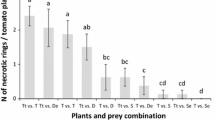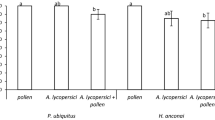Abstract
The objective of this study was to determine whether differences in hairiness of tomato plants affect the functional and numerical response of the predator Neoseiulus californicus McGregor attacking the two-spotted spider mite, Tetranychus urticae Koch. Two tomato hybrids with different density of glandular hairs were used. The functional response was measured by offering eggs and adults of T. urticae at densities ranging from 4 to 64 items per tomato leaflet (surface ca. 6.3 cm2); eggs were offered to predator protonymphs and deutonymphs, adult spider mites to adult predators. The number of spider mites eaten as a function of initial density was fitted to the disc equation. Predator densities were regressed against initial prey densities to analyze the numerical response. The number of eggs and adults of T. urticae eaten by N. californicus was extremely low in both hybrids. The nymphal stage of N. californicus and prey density had a significant effect on the number of T. urticae eggs eaten by the predator, while hybrid had no effect. The functional response fitted reasonably well to the Holling model. The handling time (T h) and the attack rate (a) were very similar among the two hybrids. The numerical response indicated that the absolute density of predators increased with changes in spider mite densities but the relative predator/prey density decreased in both hybrids. Tomato hairiness prevented N. californicus from exhibiting a strong numerical response and the predator functional response was much lower than observed in other host plants and other phytoseiids. This result shows the need to consider plant attributes as an essential and interactive component of biological control practices.
Similar content being viewed by others
References
Barbosa, P. andLetourneau, D. (eds) 1988. Novel Aspect of Insect-Plant Interactions. Wiley, New York.
Begon, M.Mortimer, M. andThompson, D. 1996. Population Ecology, 3rd edn. Blackwell Science, Oxford.
Bottrell, D.Barbosa, P. andGould, F. 1998. Manipulating natural enemies by plant variety selection and modification: a realistic strategy Ann. Rev. Entomol. 43: 347-367.
Cédola, C. 2001. Efecto de los tricomas glandulares de Lycopersicum esculentum en la interacción establecida entre arañuelas tetraníquidas y ácaros fitoseidos [Acari: Tetranychidae: Phytoseiidae]. Tesis Doctoral, Universidad Nacional de La Plata.
Chatzivasileiadis, E.Boon, J.J. andSabelis, M.W. 1999. Accumulation and turnover of 2-tridecanone in Tetranychus urticae and its consequences for resistance of wild and cultivated tomatoes. Exp. Appl. Acarol. 23: 1011-1021.
Eigenbrode, S.Trumble, J. andWhite, J. 1996. Trichome exudates and resistance to beet armyworm (Lepidptera: Noctuidae) in Lycopersycum hirsutum f. typicum accessions. Environ. Entomol. 25: 90-95.
Everson, P. 1979. The functional response of Phytoseiulus persimilis (Acarina: Phytoseiidae) to various densities of Tetranychus urticae Koch (Acarina: Tetranychidae). Can. Entomol. 111: 7-10.
Fan, Y. andPettit, F. 1994. Parameter estimation of the functional response. Environ. Entomol. 23: 785-794.
Farrar, R. andKennedy, G. 1987. 2-undecanone, a constituent of the glandular trichomes of Lycopersicum hirsutum f. glabratum: Effects on Heliothis zea and Manduca sexta growth and survival. Entomol. Exp. Appl. 43: 17-23.
Fernando, M. andHassell, M. 1980. Predator-prey responses in an acarine system. Res. Popul. Ecol. 22: 301-322.
Greco, N.Liljesthröm, G. andSánchez, N. 1999. Spatial distribution and coincidence of Neoseiulus californicus and Tetranychus urticae (Acari: Tetranychidae: Phytoseiidae) on strawberry. Exp. Appl. Acarol. 23: 567-580.
Hassell, M. 1978. The Dynamics of Arthropod Predator-prey Systems. Princeton University Press, Princeton, NJ.
Holling, C. 1959. Some characteristics of simple types of predation and parasitism. Can. Entomol. 91: 385-398.
Huffaker, C.Messenger, P. andDeBach, P. 1971. The natural enemy component in natural control and the theory of biological control. In: Biological Control, C. Huffaker (ed.), pp. 16-68. Plenum, New York.
Izraylevich, S.Gerson, U. andHasson, O. 1996. Numerical response of a parasitic mite: host effect and mechanism. Environ. Entomol. 25: 390-395.
Johnson, M. 1997. Interaction of resistant plants and wasp parasitoids of Heliothis virecens (Lepidoptera: Noctuidae). Environ. Entomol. 26: 207-214.
Johnson, M. andGould, F. 1992. Interaction of genetically engineered host plant resistance and natural enemies of Heliothis virecens (Lepidoptera: Noctuidae) in tobacco. Environ. Entomol. 21: 586-597.
Kauffman, W. andKennedy, G. 1989. Relationship between trichome density in tomato and parasitism of Heliothis sp. (Lepidoptera: Noctuidae) eggs by Trichogramma spp. (Hymenoptera: Trichogrammatidae). Environ. Entomol. 18: 698-704.
Krips, O.Kleijn, P., Willems, P.Gols, G. andDicke, M. 1999. Leaf hairs influence searching efficiency and predations rate of the predatory mite Phytoseiulus persimilis (Acari: Phytoseidae). Exp. Appl. Acarol. 23: 119-131.
Laing, J. andOsborn, J. 1974. The effect of prey density on the functional and numerical responses of three species of predatory mites. Entomophaga 19: 267-277.
Luckwill, L. 1943. The Genus Lycopersicum. The University Press, Aberdeen.
Mesa, N.Belloti, A. andDuque, M. 1987. Tablas de vida de Mononychellus progresivus Doreste y Tetranychus urticae (Koch) (Acarina: Tetranychidae) en yuca. Rev. Colombiana de Entomol. 13: 11-22.
Messina, F. andHanks, J. 1998. Host plant alters the shape of the functional response of an aphid predator (Coleoptera: Coccinellidae). Environ. Entomol. 27: 1196-1202.
McMurtry, J. andCroft, B. 1997. Life styles of phytoseiids mites and their roles as biological control agents. Ann. Rev. Entomol. 42: 291-321.
Nihoul, P. 1993. Do light intensity, temperature and photoperiod affect the entrapment of mites on glandular hairs of cultivated tomatoes? Exp. Appl. Acarol. 17: 709-718.
Obrycki, J. andTauber, M. 1984. Natural enemies on glandular pubescent potato plants in the greenhouse: an unreliable predictor of effects in the field. Environ. Entomol. 13: 679-683.
Price, P.Bouton, C.Gross, P.McPheron, B.Thompson, J. andWeis, A. 1980. Interactions among three trophic levels. Influence of plants on interactions between insect herbivores and natural enemies. Ann. Rev. Ecol. Syst. 11: 41-65.
Rogers, D. 1972. Random search and insect population model. J. Anim. Ecol. 41: 369-383.
Sabelis, M.W. 1985. Reproductive strategies. In: Spider Mites. Their Biology, Natural Enemies and Control, W. Helle andM.W. Sabelis (eds), Vol. 1A, pp. 265-278. Elsevier, Amsterdam.
Shipp, J. andWhitfield, G. 1991. Functional response of the predatory mite, Amblyseius cucumeris (Acari: Phytoseiidae), on western flower thrips, Frankliniella occidentalis (Thysanoptera: Thripidae). Environ. Entomol. 20: 694-699.
Sokal, R. andRohlf, F. 1995. Biometry, 3rd edn. Freeman, New York.
Solomon, M.E. 1949. The natural control of animal populations. J. Anim. Ecol. 18: 1-35.
Stoner, A. andStringfellow, T. 1967. Resistance of tomato varieties to spider mites. Am. Soc. Hort. Sci. 90: 324-329.
Van Haren, R.Steenhuis, M.Sabelis, M.W. andDe Ponti, O. 1987. Tomato stem trichomes and dispersal success of Phytoseiulus persimilis relative to its prey Tetranychus urticae. Exp. Appl. Acarol. 3: 115-121.
Wang, B. andFerro, D. 1998. Functional response of Trichogramma ostriniae (Hymenoptera: Trichogrammatidae) to Ostrinia nubilalis (Lepidoptera: Pyralidae) under laboratory and field conditions. Environ. Entomol. 27: 752-758.
Zar, J. 1996. Biostatistical Analysis, 3rd edn. Prentice Hall, New Jersey.
Author information
Authors and Affiliations
Rights and permissions
About this article
Cite this article
Cédola, C.V., Sánchez, N.E. & Liljesthröm, G.G. Effect of Tomato Leaf Hairiness on Functional and Numerical Response of Neoseiulus Californicus (Acari: Phytoseiidae). Exp Appl Acarol 25, 819–831 (2001). https://doi.org/10.1023/A:1020499624661
Issue Date:
DOI: https://doi.org/10.1023/A:1020499624661




